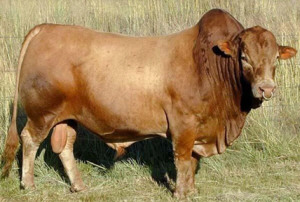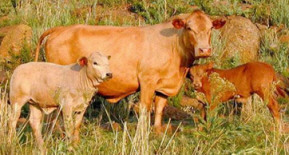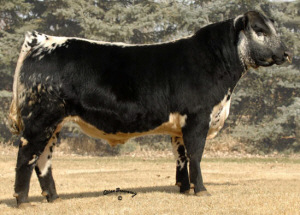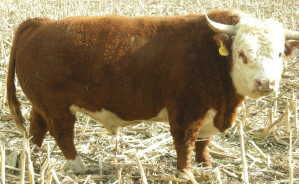



Tuli
History
The Sanga breed from which Tuli originate from evolved several thousand years ago in Africa. It is thought that the breed was the result of natural mixing of indigenous cattle with the Zebu cattle, which were herded through the continent by nomads during the first Arab invasion.They have most likely existed in their present form for more than 5,000 years.
 Photo courtesy of Tuli Cattle Breeders Society of SA,www.studbook.co.za |
Most are a light shade, ranging from yellow to reddish - brown and have a humped neck. They can have either short or long horns, depending on the exact ancestry of any given animal.
Of the many Sanga derivations, the Tswana cattle are perhaps the most interesting for Tuli enthusiasts. The Tswana cattle wandered South into Zimbabwe and developed the rugged heartiness that typifies the Tuli breed. Due to the extreme climate, the Tswana became heat and drought tolerant, and learned to find new food sources when conditions worsened. Because the Tswana had to become scavengers, they developed thick, strong legs and hard hooves from walking to water and food sources. Wrought with parasites, disease, heat, drought, and famine, these cattle experienced a harsh evolution that should have driven them to extinction.
The most docile and domesticated Tswana cattle were selected by local Matabele chiefs for their herds, and their selective breeding practices and domestication enhanced the breed and refined its evolution. Thanks to the Matabele, the Tswana continued to prosper, and only 60 years ago became the foundation for the Tuli breed as we know it today.
In the early 1940's, near Tuli, Rhodesia, a South African named Len Harvey began his life's work establishing an indigenous domestic breed of cattle that could withstand the harsh conditions of the region and still provide quality food and dairy attributes to the native farmers.
Harvey's dream was that communal farmers might benefit from his work. After observing the many variations of cattle native to the region, he chose the specimens that were the healthiest, heartiest, and most fertile. These, from the Sanga breed, became the "mother herd" for today's Tuli. Through his position with the Rhodesian Agricultural Department, he established a government breeding program in Gwanda, Rhodesia, on a 3000 acre farm he aptly named Tuli Station.
By 1948, Harvey's cattle were competing at block shows throughout Zimbabwe and Rhodesia. They won consistently year after year, beating out European contenders that had over 300 years of formal breeding management behind them. The Tuli had all of the ruggedness that thousands of years of evolution in Southern Africa had fostered, yet still maintained a high beef and dairy quality that rivaled established breeds.
These characteristics are the driving force behind the Tuli's growing popularity today. Commercial farmers soon began taking an interest in Harvey's breed. Struggling with a name for the breed, many farmers wanted them to be called Harvey's Cattle. But Len Harvey had another name in mind. Since the breed originated in Tuli, Rhodesia, and they were the colour of the red silt of the Tuli River, Harvey thought Tuli was a fitting name.
Characteristics
Tulis are moderate framed cattle and have three basic coat colours - red, yellow and white. These colours enable them to adapt to intense sunlight.Their coat is smooth, they have moderate sized ears and dewlap and they can be horned or polled.
Tulis are known for their early maturity, docile nature, good mothering ability and high fertility, and they can withstand intense heat without showing signs of stress. Due to their unique genotype, Tulis offer the maximum hybrid vigour in a crossbreeding program. They are highly disease-resistant, especially to tick-borne diseases.
Tuli cattle produce high quality beef, their meat receives consistently excellent ratings for its flavour, tenderness and marbling, and usually Tuli Cattle are large enough to be slaughtered at about 18 months of age.
Statistics
 Photo courtesy of Tuli Cattle Breeders Society of SA, www.studbook.co.za |
Comparative
Dr. Bill Holloway of Texas A&M University stated it best when referring to his research conclusions: "The most significant results are the pounds of calf weaned per pound of cow exposed. The Tuli-crossed calves weaned 75% more pound of calf per cow exposed that Brahman: 53% more than Angus and 21% more than Senepole. This points to the efficiency, productivity, and adaptability of the Tuli. If you are running cattle in a hostile environment, with limited feed resources," added Dr. Holloway, "this study is very significant. For producers seeking optimum production, the Tuli offers tremendous advantages."www.tuliassociation.com
Distribution
The Tuli is produced in South Africa, Australia and North America.References (the above information was cited from the following sites)
www.tuliassociation.com
www.tuli.co.za
www.studbook.co.za


